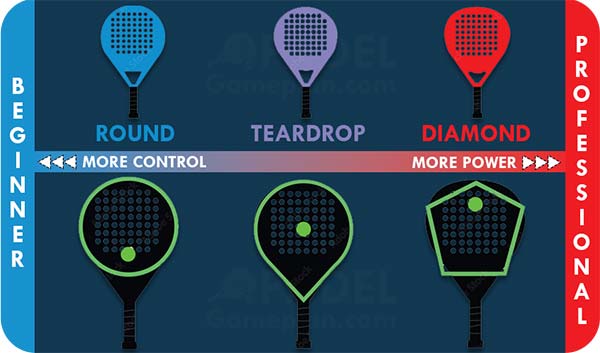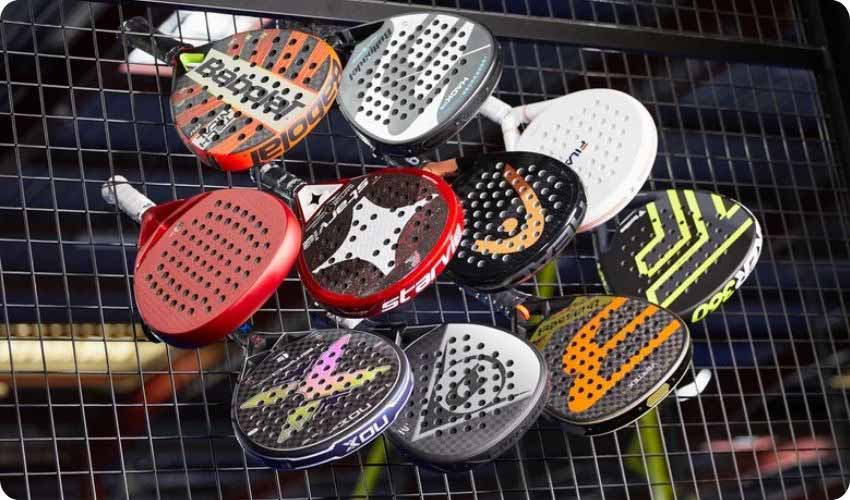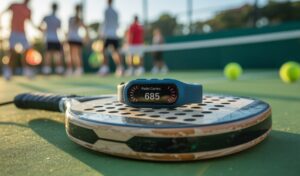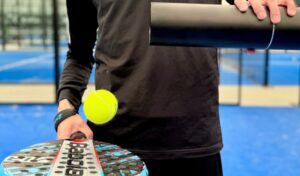Choosing the padel tennis racket can make a world of difference as this will improve your performance on court.
Most importantly, this guide will help you select the correct padel racket tailored to your skill level – beginner, advanced or professional.
Parts of a Padel Tennis Racket
To choose the right racket, you first need to understand its main components.
- Face: The area of the padel tennis racket that makes contact with the ball.
- Dampener: At the top of the padel tennis racket (in opposite-U curve shape) reduces the vibration and increases the strength of the shot.
- Impact Surface: The part of the padel tennis racket paddle to contact the ball.
- Core: Usually a rubber foam material that adds elasticity and power.
- Holes: Lightens the frame weight and optimizes for spin for better control and maneuverability.
Shape of a Padel Tennis Racket
A padel tennis racket is designed to have a specific shape that determines your playing style. There are three main types:
- Round: Best for control and precision, decent for beginners.
- Teardrop: It offers a fantastic combination of power and control and is well-suited for intermediate-level players.
- Diamond: Most suitable for power killers, popular with professionals.

Shape: The balance and sweet spot.
| Round padel racket | Offers control and a centrally located sweet spot. |
| Teardrop padel racket | Balances power and control, with an elevated sweet spot. |
| Diamond padel racket | Maximum power with a higher sweet spot, suitable for aggressive play. |
Weight Considerations
The weight of your padel tennis racket will influence powerful hits and maneuverability. A heavy padel tennis racket (370-390 g) allows for more power. A light padel tennis racket (350-370 g) provides better control.
Balance and Sweet Spot
- Low balance: More control to one person, good for a new one.
- Medium: A combination of power and control, good for all kinds of players.
- High balance: High power, one hold for aggressive players.
Core Material
There are different types of core materials of high-quality rackets:
- EVA foam: Durable, firm for body stabilization and energy balance.
- Soft Foam: Provides better rebound and comforts by reducing vibrations.
Frame Material
Frame materials impact durability and performance for padel tennis rackets:
- Carbon Fiber: Light yet very strong and durable.
- Fiberglass: Cheap and flexible.
- Kevlar: Located in high-end padel tennis rackets for high durability.
Impact Surface Material
- Fiberglass: Softer and quite a bit more flexible which provides comfort.
- Carbon Fiber: Enhances strength and durability.
- Graphene: Best material for serious padel tennis racket players.
Grip and Handle Size
- Choosing the correct grip size will make it comfortable and will prevent injuries.
- A fatter grip absorbs most of that shock.
- A thinner grip affords some wrist movement.

What Material Is Right for You?
A comparison of these four materials is below to help you find what would work best for you:
Frame Material
- Beginner: Lightweight carbon frame padel tennis rackets are best for handling and maneuverability.
- Intermediate: Opt for carbon frames for pop and toughness or fiberglass frames for flexibility and affordability.
- Pros: Go for hybrid carbon and Kevlar frames for strength and responsiveness and competitive performance.
Core Material
- Beginner: Foam cores provide a more forgiving feel and help develop control.
- Intermediate: EVA cores offer a healthy power/precision balance for versatile playstyles.
- Pros: EVA cores are more suited for defensive play (better shock absorption) and foam cores, offensive strategies (better energy transfer).
Impact Surface Material
- Beginner: For surfaces of padel tennis rackets made of 3K carbon fiber, this will give the new placers more control and accuracy. For more power, 6K/9K carbon fiber is suggested.
- Intermediate: Fiberglass padel tennis racket faces provide a strong, heavy feel for consistency, and 6K/9K carbon fiber enhances punch on aggressive shots.
- Pros: For surfaces of padle tennis rackets made of 12K carbon fiber, this will give good strength, precision and top-tier performance.
Key Takeaways
- For beginners, lightweight control-focused materials help establish the building blocks of their skills.
- Intermediates can choose carbon/fiberglass frames for more rigidity/flexibility, EVA cores for balance.
- Industry experts gravitate toward proprietary materials (Kevlar hybrids, 12K carbon, elements of other composites) that maximize output, resistance, and torque, tactical capability. The changing needs of players mirror the evolving materials they use, as they refine their skill level into control, power, and adaptability.
The Best Padel Tennis Rackets for Every Style of Play
- Beginner: Look for lightweight padel tennis rackets with rounded shapes and soft foam cores.
- Intermediate: A medium-weight teardrop racket with high-grade EVA foam for power with control.
- Pros: High-density carbon fiber padel rackets allow for optimal power (rackets in a diamond structure).
Conclusion
In order for you enhance your game and performance, you need to invest in a quality padel tennis racket.
Use this guide to help you choose the right padel tennis racket for you. There is a wide product range to choose from on Amazon or your local padel tennis shop. Do you want to improve your Padel Game Plan? Stay tuned for more insights about the game at PadelGamePlan.com!
FAQ – PADEL RACKETS
What is the best way to choose a padel tennis racket for me?
Consider your skill level, playing style, and budget. New players look for control – advanced may prefer power-oriented padel tennis rackets. For more information, please read this Article.
What’s the best padel racket for beginners?
A lightweight and round padel tennis racket made of a fiberglass frame would be right for beginners.
How often should I change my padel racket?
It depends on usage. Casual players will probably replace every 1-2 years, and competitors will change it every year.
Do you want a heavier or light padel tennis racket?
A light padel racket gives you more precision – A heavy racket gives more power.
What is the difference between carbon and fiberglass padel tennis rackets?
Carbon padel tennis rackets assist with runtime and power – Fiberglass padel rackets provide versatility and comfort.
FAQ – PADEL IMPROVEMENT
How to get better at padel?
You will need regular practice, hit on the walls and watch matches of professionals. Read this Article – How to play Padel Tennis.
How can I improve my Service?
For more information on Padel Service, please read the Article – Best Padel Serve Techniques
Can I know more about the Rules of Padel Tennis?
Absolutely, for a beginner-friendly explanation of the Rules of Padel Tennis, please have a look at the Article – Rules of Padel Tennis. For Official Rules, please download the official rules of Internatlonal Padel Federation here.
FAQ – PADEL FOR CHILDREN
At what age should children start Padel Tennis for children?
Children as young as 4 can start out with foam balls and mini-rackets. The majority of clubs are for ages 5–15.
How does padel improve teamwork in kids?
Doubles requires constant communication and mutual strategies; collaboration is natural.
Can padel help academically?
Doubles requires constant communication and mutual strategies; collaboration is natural.
What is a good reason why padel is safer than tennis for little kids?
Enclosed courts, slower balls, and lighter gear reduce injury risks significantly.
Is there any competitive padel opportunity for kids?
Absolutely! Try to look for Junior leagues that offer Padel tournaments for under-12 and teen divisions. the positive impact of padel tennis on children
FAQ – PADEL EQUIPMENT
Do I need special padel tennis attire?
Please read the Article – Top Padel Clothing Essentials.
Do you have a checklist of padel tennis essentials I’ll need?
Could you recommend which padel balls I should use?
Please read the Article – Best Padel Balls.
Planning a Padel Tournament?
Use our Free Tool and get the schedule in seconds.
FAQ – PADEL TENNIS COURT
Is it possible to erect a padel court in my garden?
Installation is possible with a minimum area of 10m × 20m, subject to local zoning approval. For more information, Read this Article.
How much the cost of a padel court?
A typical padel court can range from AED 335,000 to AED 1,113,000, depending on materials, location and amenities. See the full cost breakdown here: Article – How much does it cost to build a padel court.
What about lighting required for the padel court – what advice can you give on that?
Please have a read through on the Article – Essential Padel Lighting Tips.









One Response